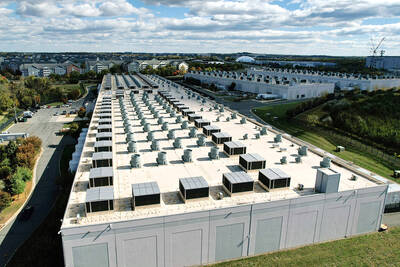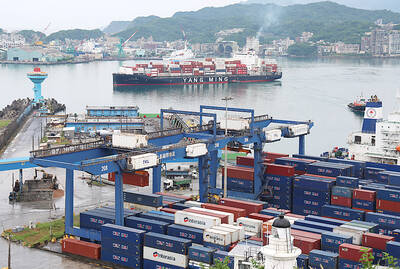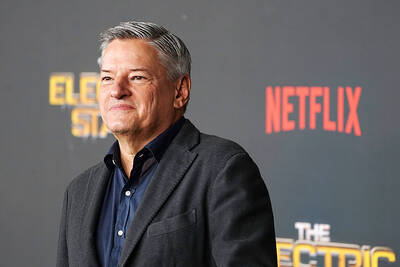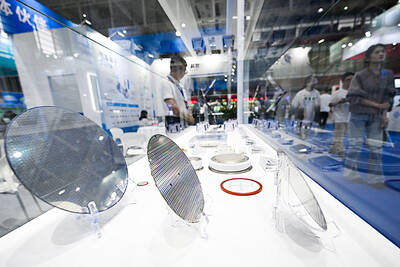Nan Ya Plastics Corp (南亞塑膠), the nation’s largest plastics maker, yesterday gave a relatively optimistic outlook for the rest of the year, supported by rising demand for copper products, oil and ethylene glycol.
“The demand for electric material and ethylene glycol has been improving,” chairman Wu Chia-chau (吳嘉昭) told reporters on the sidelines of an annual shareholders’ meeting in Taipei, citing strong growth momentum in the global electric-vehicle market.
Nan Ya has set a sales target of 69.65 million copper-clad laminates and 2.35 million tonnes of ethylene glycol this year, the firm said.
Wu said that Nan Ya is working on four capacity expansion projects this year, as part of its near-term efforts to sustain competitiveness and meet growing demand.
The company’s board last month approved a NT$5.37 billion (US$176.6 million) proposal to build a new plant in Taiwan to expand production capacity for copper foil, aiming to satisfy increasing global demand for lithium-ion batteries, a key component of electric vehicles.
The plant is to produce 18,000 tonnes of copper foil per year, lifting the company’s annual capacity from 90,000 tonnes to 108,000 tonnes, the plastics maker said.
Nan Ya, a key member of the Formosa Plastics Group (台塑集團), runs several copper foil plants in Chiayi County and Kunshan City in China’s Jiangsu Province.
Nan Ya’s board also approved a plan to expand its production capacity of high value-added synthetic paper, a company filing with the Taiwan Stock Exchange showed.
The plan, which is to cost NT$1.19 billion, is expected to raise its annual capacity from 65,000 tonnes to 87,000 tonnes.
As for overseas markets, Nan Ya is to build a new plant to produce ethylene glycol in Texas, eyeing cheaper natural gas costs there.
Nan Ya said it is also to construct a new plant in Jiangsu, which would manufacture faux leather for Chinese automakers, without providing a timetable.
Shareholders approved a proposal to distribute cash dividends of NT$4.5 per share, the highest in the past six years, based on a net profit of NT$48.84 billion last year, or earnings per share of NT$6.16.
Profit last year surged 36.7 percent from a year earlier, but sales over the same period fell 8.2 percent to NT$275.29 billion, primarily due to lower crude oil prices in the first three quarters of last year.
The company attributed the better-than-expected earnings performance to profits from selling its shares of DRAM chipmaker Inotera Memories Inc (華亞科技) to Micron Technology Inc.

The demise of the coal industry left the US’ Appalachian region in tatters, with lost jobs, spoiled water and countless kilometers of abandoned underground mines. Now entrepreneurs are eyeing the rural region with ambitious visions to rebuild its economy by converting old mines into solar power systems and data centers that could help fuel the increasing power demands of the artificial intelligence (AI) boom. One such project is underway by a non-profit team calling itself Energy DELTA (Discovery, Education, Learning and Technology Accelerator) Lab, which is looking to develop energy sources on about 26,305 hectares of old coal land in

Taiwan’s exports soared 56 percent year-on-year to an all-time high of US$64.05 billion last month, propelled by surging global demand for artificial intelligence (AI), high-performance computing and cloud service infrastructure, the Ministry of Finance said yesterday. Department of Statistics Director-General Beatrice Tsai (蔡美娜) called the figure an unexpected upside surprise, citing a wave of technology orders from overseas customers alongside the usual year-end shopping season for technology products. Growth is likely to remain strong this month, she said, projecting a 40 percent to 45 percent expansion on an annual basis. The outperformance could prompt the Directorate-General of Budget, Accounting and

Netflix on Friday faced fierce criticism over its blockbuster deal to acquire Warner Bros Discovery. The streaming giant is already viewed as a pariah in some Hollywood circles, largely due to its reluctance to release content in theaters and its disruption of traditional industry practices. As Netflix emerged as the likely winning bidder for Warner Bros — the studio behind Casablanca, the Harry Potter movies and Friends — Hollywood’s elite launched an aggressive campaign against the acquisition. Titanic director James Cameron called the buyout a “disaster,” while a group of prominent producers are lobbying US Congress to oppose the deal,

Two Chinese chipmakers are attracting strong retail investor demand, buoyed by industry peer Moore Threads Technology Co’s (摩爾線程) stellar debut. The retail portion of MetaX Integrated Circuits (Shanghai) Co’s (上海沐曦) upcoming initial public offering (IPO) was 2,986 times oversubscribed on Friday, according to a filing. Meanwhile, Beijing Onmicro Electronics Co (北京昂瑞微), which makes radio frequency chips, was 2,899 times oversubscribed on Friday, its filing showed. The bids coincided with Moore Threads’ trading debut, which surged 425 percent on Friday after raising 8 billion yuan (US$1.13 billion) on bets that the company could emerge as a viable local competitor to Nvidia